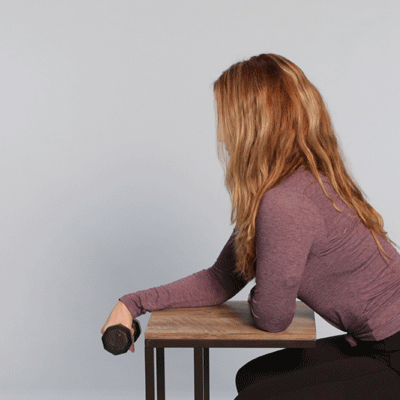People can usually treat tennis elbow at home with rest and over-the-counter (OTC) medication. Specific exercises, such as wrist turns and towel twists, can also help ease pain and prevent recurrence.
Tennis elbow, also known as lateral epicondylitis, occurs when a person strains the tendons in their forearm.
Before trying these exercises, it is best to wait for any swelling to go down. It is also a good idea to check with a doctor or a physical or occupational therapist first.
A person needs to perform this exercise while sitting. To perform a wrist turn:
- Bend the elbow at a right angle.
- Extend the hand outwards, palm facing up.
- Twist the wrist around gradually, pointing the thumb to the ceiling.
- Continue turning the wrist slowly until the palm is facing down.
- Slowly return to the starting position.
- Perform 5 to 10 repetitions, depending on the comfort level.
To perform a wrist extension with weight, a person can:
- Begin with their forearm supported on a table with their palm facing down.
- Hold a small weight, such as a small dumbbell or a tin of food.
- Use the opposite hand to raise the wrist up as far as possible.
- Slowly bend the wrist down as far as possible without the support of the other hand.
- Perform 5 to 10 repetitions, depending on the comfort level.
A person needs to perform this exercise while sitting.
To perform a wrist flexion:
- Grip a light weight, such as a small dumbbell or a tin of food.
- Bend the elbow at a right angle.
- Extend the hand outwards, palm facing up.
- Bend the wrist up toward the body.
- Hold this position for 5 seconds, then release slowly.
- Repeat 9 more times.
- Do two more sets of five to 10 repetitions, depending on the comfort level.
To perform the elbow bend:
- Stand straight.
- Lower the arm to one side.
- Slowly bend the arm upward until the hand comes as close to the shoulder as comfortably as possible.
- Hold this position for 15 to 30 seconds.
- Repeat 9 more times.
To perform the wrist extensor stretch:
- Raise the arm straight out in front of the body.
- With the palm facing down, slowly bend the wrist downward.
- Using the other hand, gently pull the fingers back toward the body.
- Hold this position for 15 to 30 seconds.
- Straighten the wrist again.
- Do 2 more sets of 3 repetitions.
To perform the wrist flexor stretch:
- Raise the arm straight out in front of the body.
- With the palm facing up, slowly bend the wrist upward.
- Using the other hand, gently pull the fingers back toward the body.
- Hold this position for 15 to 30 seconds.
- Straighten the wrist again.
- Do 2 more sets of 3 repetitions.
To perform the fist squeeze:
- Use a rolled-up towel, sock, or stress ball and place it in the palm.
- Grip the ball or towel with the fingers to form a fist.
- Squeeze tightly for 10 seconds.
- Repeat 9 more times.
To perform the towel twist:
- Hold a loosely rolled-up towel lengthways, with one hand at each end.
- Keep the shoulders relaxed.
- Twist the towel by moving the hands in opposite directions as if wringing out water.
- Repeat 9 more times.
- Repeat 10 more times, twisting the towel in the reverse direction.
Ceasing or reducing repetitive activities and resting the arm can aid recovery. When resting is not possible, adjusting arm movements can help ease symptoms. For example, a person can try keeping their palms flat and elbows bent when lifting.
Exercises suitable for tennis elbow can help strengthen forearm muscles and improve function. People whose jobs involve repetitive forearm movement can perform these exercises to help prevent tennis elbow from returning.
However, people always need to consult a doctor before attempting exercises for their tennis elbow. A doctor can help ensure these activities will not affect any underlying conditions or injuries.
If exercising the forearms seems to worsen symptoms of tennis elbow, a person can try:
- resting the arm for longer
- using an ice pack on the arm to help reduce inflammation
- taking OTC medication, such as ibuprofen, to help relieve pain and inflammation
- speaking with a doctor or physical therapist to ensure they are performing the exercises properly
Most of the time, a person can manage tennis elbow with rest and OTC medication. If the pain worsens or persists even with rest and exercise, it is best to consult a doctor.
A doctor may prescribe a stronger nonsteroidal anti-inflammatory drug (NSAID), a steroid injection, or recommend physical therapy to improve motion and reduce pain.
A brace or strap may also help reduce strain during repetitive tasks.
Tennis elbow, or lateral epicondylitis, occurs when a person strains the tendons in their forearm.
In most cases, people can treat tennis elbow at home with rest and over-the-counter medication, but certain exercises can also help reduce pain and prevent recurrence. These include wrist turns, towel twists, and fist squeezes.
Allowing swelling to subside before starting exercises and consulting a doctor or physical therapist for guidance is important.




